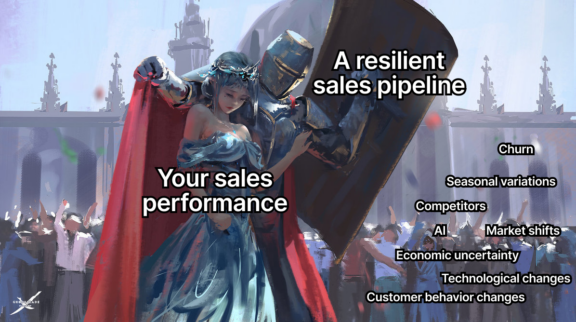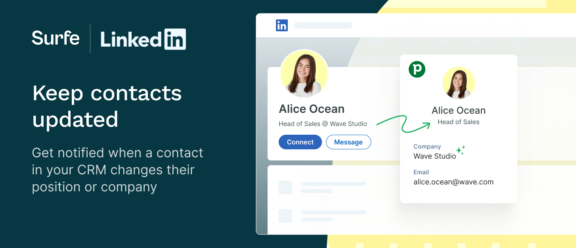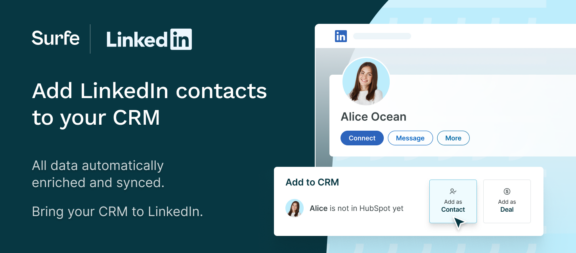How to Build and Maintain a Resilient Sales Pipeline

There’s a lot going on in the world – in this blog post, we’ll dive into how to build and maintain a healthy sales pipeline whatever the market conditions are.
Think back to the last five years. A global pandemic. An economic downturn. Mass redundancies. Let’s not even mention politics.
Super chill, right? 🥰
Ok, obviously we’re kidding. But our point is – a lot can change in five years. In one year, even! And with every change comes a potential impact on your sales pipeline.
Macro conditions may be out of your control – but that doesn’t mean that your job performance is. Even in the most turbulent of times, the salespeople at the top of their game will find a way to stay resilient and keep their number one spot.
How?
By building and maintaining a killer sales pipeline. In doing so, you’re creating opportunities left, right, and centre – no matter what the world around you looks like – and managing them through to closing with no extra hassle.
Here’s what we’re going to cover:
- Understanding current market uncertainties
- Why a resilient sales pipeline is important
- Building a resilient sales pipeline: strategies
- Maintaining pipeline health – even when things feel uncertain
- Leveraging technology to stay ahead
- Best practices for sales teams
On your marks, get set…

Understanding current market uncertainties
B2B sales might feel hard at the moment. (or it might not – if you’re one of those people, just know we’re not at all jealous). Here’s why that might be:
Economic trends: as we all know, the economy’s not a pretty picture. Prices are rising, interest rates are through the roof, and there are global supply chain disruptions due to wars and instability. The people you’re trying to sell to probably have to do more with less money – and every spend will be carefully analysed for ROI.
Technological changes: let’s not ignore the massive elephant in the room. AI is here to stay. This is super exciting for sales processions if (and it’s a big if) it’s used correctly. Plenty of teams have rushed to adopt generative AI tools without taking the fact they’re still in their infancy into account. Plus, there’s some anxiety around whether it will allow businesses to cut down the size of their teams – or replace some roles entirely.
Market shifts: the way people make purchases is changing – particularly in a B2B context. You might have to jump through more hoops than ever before, or completely change your approach to sales from previous years. Plus, there are industry regulations to keep ahead of, and competition’s springing up out of nowhere.
The importance of a resilient sales pipeline
So, things might not feel easy. But you’re not reading this blog post because you want tea and sympathy, are you?
Instead, you’ve come here to find out how to build resilience in the face of tough market conditions – and that’s what we’re going to deliver. Before we begin, though, let’s take a second to find out what resilience actually means.
A resilient sales pipeline has three key characteristics:
Flexibility: your sales pipeline should be easy to adjust or improve, no matter what changes you throw at it.
Adaptability: a pipeline that changes with market conditions, not because of them. After all, you don’t want to be playing catchup six months after a major event has changed your buyer’s pain points, do you?
Sustainability: one common mistake we see when it comes to sales pipeline management – particularly in smaller, more volatile companies – is putting all efforts into the current quarter, and not considering what’s going to come after that. You need to have a healthy number of deals in the immediate and intermediate future.
And if you get all this right? You’ll enjoy:
- Improved conversion rates
- Consistent revenue flow
- Better customer relationships
Plus, you can say goodbye to being a stressed salesperson under pressure. Instead, you’ll be cool as a cucumber.
Building a resilient sales pipeline: strategies
Sold? We thought so. Here’s how to actually put it into practice:
Diversify your lead sources
Relying on a single lead source to build your entire pipeline is going to end in disaster. No, we’re not exaggerating! Think about the impact the introduction of GDPR had on marketing teams and outbound, for example.
Diversification impacts accuracy, too. Take finding emails – you use an email finder, right? (if not – we’re in 2024. What are you doing!?). But what if that email finder is wrong? Using more than one tool helps to mitigate this risk.
Utilize your CRM effectively
Your customer relationship management software is an essential tool in your building-a-resilient-pipeline arsenal. You need to make sure it’s equipped to handle every stage of your sales process – from filling it with prospects, to moving these potential customers down the sales funnel, to closing deals.
Top-tier CRMs include Hubspot, Salesforce and Pipedrive (just in case you haven’t heard of them before). One of the best things about them is how well they integrate with other tools – like Surfe! – which streamlines handling your pipeline.
Prioritize automation and efficiency
You can have the most wonderful pipeline in the world – but if it takes hours upon hours to build and maintain, it’s not really resilient. Doing everything – like updating contact data, or enriching information – yourself means you won’t have the time to actually work on your pipeline. Which kind of defeats the point.
When you’re choosing tools to help you manage your pipeline, look out for automation as a key feature. Need an example? Surfe automatically updates your CRM with contact information from LinkedIn – so if your prospect gets promoted or changes jobs, your CRM will have the right info. No effort on your part required.
Maintaining pipeline health during uncertainty
Now we’ve built ourselves a healthy pipeline, it’s time to maintain it. Here’s how.
Regularly update data
As we mentioned before, keeping data that’s up-to-date is key to a healthy pipeline. You don’t want to base all your hopes and dreams on one prospect, only to find your key decision-maker moved somewhere else six months ago.
There’s no beating around the bush: this process is usually time-consuming. But it doesn’t have to be! Automate as much as you can with tools like Surfe, which automatically registers and updates changes to LinkedIn profiles.
Stay on top of monitoring and analytics
The best sales professionals are those that are comfortable – more than comfortable – with data. You’ll want to keep an eye on key performance indicators (KPIs) to monitor pipeline health, adjust strategies and set sales targets as needed.
Metrics to track include:
- Win rate
- Sales cycle length
- Average deal size
- Pipeline coverage
- Velocity
- Deal drop-off
Sales goals = a motivated and excited team, after all.
Optimize your outreach
You want to keep all your processes in top shape – particularly when it comes to filling your pipeline. Make sure your LinkedIn messaging is spot on, and your email delivery rates are high.
Tip: Surfe can help with both 😉 whether it’s optimizing and sharing your LinkedIn follow-up templates with teammates, or aggregating providers to find the most accurate email data, it works to keep your activities at the top of the sales pipeline smooth and simple.

Leveraging technology to stay ahead
A big part of a resilient sales pipeline that hits revenue goals is the technology that fuels it. We’ve got a quick roundup of current sales tech trends for you to use:
AI and machine learning
AI is brilliant in many ways. It’s great at helping sales teams with repetitive (often tedious) tasks, like responding to proposal requests, lead scoring or keeping data up-to-date. It can also help sales leaders analyse their sales activities – and make predictions on market trends and customer behaviours, as well as identifying problems like bottlenecks.
Our tip? The best approach is to layer AI with the human touch – have it write that email, then write the second draft. Take time to personalise your prompts so the findings are unique – and helpful – to your business.
Sales tool integrations
When choosing your sales tools, make sure that integration is at the top of your ‘needs’ list. There’s no point in choosing a shiny new data enrichment tool if it doesn’t integrate with your CRM software, for example – you’re just setting yourself up for heartache (and a whole load of admin).
Hint: if your business is growing fast (thanks to your resilient pipeline, no doubt) make sure the tools you choose are scalable too. That means keeping an eye on pricing and making sure there’s a variety of integrations available in case you need to shake your tech stack up. 15+ is the gold standard!

Best practices for sales teams
Now let’s look at how sales teams should work on a pipeline together. The closer-knit a team is in its approach to sales, the more successful it’ll be:
Adaptability and flexibility: encourage team members to constantly test and learn, and think about how they can adapt to wider market conditions. If someone finds a good approach or an exciting new tool, for example, they should share it with the group.
Continuous learning and development: the sales skills needed ten years ago are not the sales skills needed today. And in ten years’ time? We’re not going to claim to be fortune tellers, but we’re pretty confident that you’ll need new ones then, too. Every team member should make training and upskilling a priority – even during busy periods.
Collaboration and communication: work in silos, and you’re setting yourself up for failure. A good sales team shares wins, losses, and strategies for success – as well as keeping each other informed about what’s going on at a macro and micro level. Teamwork makes the dreamwork *insert cheesy smile here*!
Let’s wrap it up!
If you’re familiar with the wise words of Warren Buffet (of course you are), you’ll know he said that uncertainty creates opportunity. We think that’s an excellent mindset to adopt in sales.
As the last five years have shown, the only real thing we can predict in sales is that it will change. But equip yourself with the tools to handle this change and you’ll become a better salesperson for it. Now go forth, and start building that resilient sales pipeline.

Want to ride the waves of uncertainty?
Surfe lets you do just that – and it’s not all in name. By keeping your pipeline data accurate, up-to-date, and easy to manage, it lets you focus on what you’re really good at: selling.
FAQs about building a resilient sales pipeline
How to build a strong sales pipeline?
To build a strong sales pipeline, you’ll need to diversify your lead sources, utilise your CRM effectively, and prioritise automation. Having a wide variety of potential buyer sources ensures consistency and accuracy, a CRM helps you keep track of your pipeline and analyse sales data, and automation helps you to become more efficient.
What are the four stages of a sales pipeline?
The four stages of a sales pipeline are: prospecting new leads, converting leads, managing and closing a deal, and taking post-sale actions. Analysing these four stages provides a broad overview of the health of the pipeline, and allows managers to find room for improvement.
What are the five stages of the sales pipeline?
Dividing the sales pipeline into five key stages allows sales reps to analyse their opportunities in more detail. The five different stages are:
- Prospecting: finding sales opportunities, on social media for example, and lead qualification
- Engagement: the next stage involves reaching out to leads by cold calling or warm calling using the right business phone system, email, and LinkedIn
- Lead nurturing: building relationships with leads and understanding their problem
- Conversion: turning these leads into paying customers
- Implementing and onboarding: making sure leads have a smooth transition into becoming existing customers
How do you keep a sales pipeline full?
Keep a sales pipeline full by always looking to the future. Use sales data build a sales forecast stay on top of what’s happening in the next quarter, the next half year, the next year, and beyond. When you have a complete picture of your long-term sales pipeline, you can make changes and adaptations where necessary.
Make sure that you are aware of market conditions and how these might impact your ideal customer profile behaviour right now, and in the future too.
What is an example of a sales pipeline?
A sales pipeline is another way of thinking about a sales funnel. It is often divided into four or five stages, with the first lead generation stages being the start of the relationship between prospect and business and the last stages being as the sale closes and the lead becomes a customer. How these sales pipeline stages are defined depends on your specific sales strategy and sales cycle, but broadly follow a similar pattern including prospecting, engagement, nurturing, conversion and onboarding.


